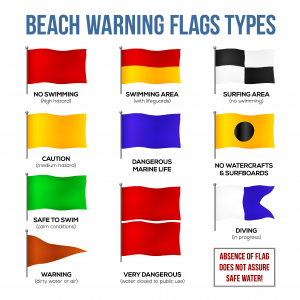Media Blog
Beach Flag Guide for Safe Summer Travel
Your familiarity with beach warning signs and safety flags (and their meanings) are of the utmost importance when visiting coastal areas this summer, whether at you decide to travel domestically or abroad.

Beach warning signs and flags provide essential information about potential hazards and help boost the safety of beachgoers everywhere! Understanding these signs helps individuals make informed decisions and take appropriate actions to stay safe, like avoiding jellyfish infested water or staying out of dangerous water currents. Reduce the risk of accidents and ensure an enjoyable beach experience with our beach flag guiide for safe summer travel!
Beach Safety Flag Descriptions:
Red Flag: A red flag indicates high hazard conditions and serves as a warning to beachgoers. It typically signifies strong currents, large waves, or dangerous surf conditions. Swimming is often prohibited when the red flag is displayed.
Yellow Flag: A yellow flag denotes moderate hazards and advises caution to those entering the water. It may indicate moderate surf or currents, making swimming more challenging and potentially risky.
Green Flag: A green flag signifies generally calm and safe conditions. It indicates that swimming is permitted, but beachgoers should still exercise caution and follow any posted guidelines.
Purple Flag: A purple flag is raised when there is a potential presence of dangerous marine life in the water. This can include jellyfish, sharks, or other marine creatures that may pose a threat. Swimmers should be cautious and follow any instructions provided by lifeguards or beach officials.
Blue Flag: A blue flag is often used to indicate that lifeguards are on duty. It signifies the presence of trained professionals who can assist in ensuring beach safety. This flag may also be accompanied by additional signs or information regarding specific rules or regulations.
Checkered Flag: A checkered flag indicates the designated area for watercraft such as surfboards, kayaks, or boats. It serves as a visual boundary, separating swimmers from areas where water activities take place. It reminds beachgoers to be mindful of the presence of watercraft and to avoid swimming in those areas.
Red/Yellow Flag: A Red and Yellow flag means “swim here” and it also indicates the presence of lifeguards. This is an especially important flag to know before you go!
Please note that the meanings and color codes of beach safety flags can vary slightly from one location to another, so do your research before you travel! It is always advisable to familiarize yourself with the specific flag system used in the region or country you are visiting! Visit local government websites before you travel to international beaches and know what dangerous marine life might inhabit that area of the world.
Keep yourself and your travel mates safe this summer!